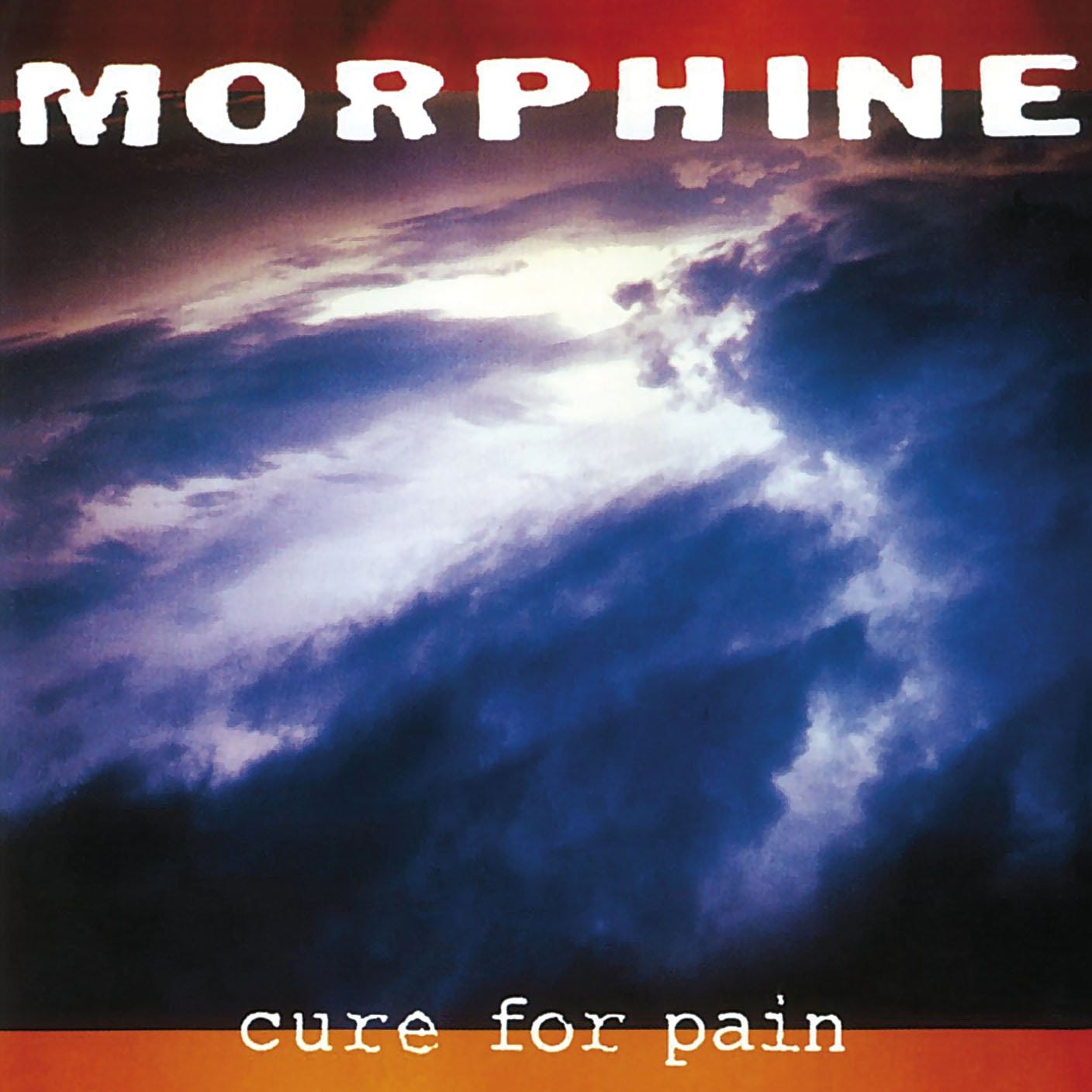"Buena" by MORPHINE
A man called Sandman named his band for another god of dreams. Their sound was low and their aspirations high. 30 years ago, they achieved both with a song about loving the devil you know.
I said come on a little closer I got something to say
Mark Sandman called Morphine's music Low Rock. It was the simplest way to describe the sound of the band. Their aesthetic prized low, deep tones — baritone saxophone, Sandman’s husky vocals, and the growls and moans of a two-string slide bass of his own devise. The simplicity of his description, however, reveals the band’s actual aesthetic, which was simplicity itself. This is more than just removing two strings from an electric bass. “Resist the temptation to add,” Sandman once explained. “If you’re going to do something to a song, subtract.” It’s music by poetic deletion, trimming away the obvious to uncover deeper meaning; it’s the difference between “Juliet is like the sun” and “Juliet is the sun.”
Lyrically, Sandman is more Jim Thompson or James Ellroy than Shakespeare. Spinning tales of trysts lit in happy hour gloaming, he had an ace crime writer’s concision and eye for detail. It’s a style that carried over from his previous band, the busier and bluesier Treat Her Right. Paired with Dana Colley’s saxophones (plural; he sometimes played two at once, a la Rashaan Roland Kirk), singing these lyrics in conspiratorial stage whisper gave Morphine its noir overtones. Film Noir, defined by the shadows and sharp contrasts of cost-effective low-key lighting, also succeeded by doing more with less.
“Buena” was the lead single from Morphine’s second album, Cure for Pain. After the 43 second opening track “Dawna,” where Colley blows softly as if from a ‘50s tenement window, the song is introduced by the naked grind of Sandman’s slide bass. The sound is as arresting now as it was when the record was released in 1993 — the central riff of the song in the form of these bare bass chords. Before drummer Billy Conway clatters in on his (again, minimal) drumkit, it’s just you and the sighs of the slide the moans of the strummed of bass strings. Sandman’s “low, murky” bass could roar like a V8 race motor, but here it’s alluring, sexy, and mysterious, spiking your curiosity for what else lurks in the song’s shadows.
I hear a voice from the back of the room
I hear a voice cry out you want something good
Well come on a little closer let me see your face
Yeah come on a little closer by the front of the stage
Sandman sings the opening lines over just bass and drums — the song goes on over a minute before we hear Colley’s sax. Breaking the fourth wall, singing as a singer in band, only completes the seduction. It is a song, after all, about willingly getting in over your head, a point underscored by the ecstatic, skronky heights reached by Colley's sax in the fierce groove that anoints the close of the chorus.
And since I met the devil I ain't been the same oh no
And I feel all right I have to tell ya
I think it's time for me to finally introduce you to the
Buena Buena Buena Buena good good good
We don’t know if the “devil named Buena Buena” is a who or a what. When you call your band Morphine, you have to expect that people will assume it’s a drug. Which is fair enough. But that’s also a little too obvious. Part of any seduction is what each of us volunteers of ourselves. Here, it's how a listener populates the song’s shadows. If the idea of a drug as a shortcut to the “good, good, good,” is attractive, so be it. Buena is also a woman’s name1 and the feminine form of a Spanish adjective — sung in Sandman’s gruff purr, it could just as likely be sexual. Maybe it’s just a sense of willing corruption that pulls you to the stage from the back of the room, drawn out of the shadows by desires beyond the norm, as suggested by “I know some people want to make you change / Well I I know how to make ‘em go away.”
The end of the 1941 film version of Dashiell Hammet’s ur-Noir The Maltese Falcon borrows a line from Shakespeare’s The Tempest2, when Sam Spade says that the titular black bird is “the stuff dreams are made of.” Here’s where it’s important to remember that Morphine comes etymologically from Morpheus, the Greco-Roman god of dreams. Buena is a metaphor (e.g. “Juliet is the sun”) because Buena is whatever you need a devil to be.
Mark Sandman collapsed on stage at the Giardini del Principe in Lazio, Italy in July of 1999, and died. He was 46. The cause of death was a heart attack. Again, when you’re a rock star and call your band Morphine and a record Cure for Pain, people are going to do the simple math of judgmental assumptions. By many accounts, however, Sandman had, by that point in his life, rejected drug use for all the friends it cost him3. He also had taken a hard physical path to whatever kind of rock stardom it was he’d achieved. (Morphine was on its second record of their deal with major label DreamWorks Records when he died.) Sandman pulled overtime shifts working construction, hauling nets on commercial fishing boats, and driving a cab, where during one such shift, he was stabbed in the chest during a robbery. He would take those earnings and decamp to places like rural Colorado, and his time there inspired songs like “Thursday” and Treat Her Right’s “I Think She Likes Me.” Those westward trips were an escape, just like music was an escape after the deaths of his young brothers.
Sandman, whose name was also given to a god of dreams4, put a lot of heart into achieving his own dreams; then that heart gave out. All of which is to say, we don’t know, and that we don’t have to know, why he’s gone, just that, like a dream, he is.
24 Song Playlist
Morphine, plus a song by Treat Her Right and one featuring Dana Colley.
Thank You
I got a nice note from Substack congratulating me on my first 1000 subscribers. (“First” is their word, and I appreciate that kind of optimism.) Thank you everyone who’s subscribed to this idiosyncratic project. I hope these pieces can bring you just a bit of the joy or inspiration you’ve given me.
Thank you, too, to folks like Sherman Alexie, both for recommending this newsletter and his human kindnesses, commenting on pieces and offering condolences for the loss of Martin, a pet cat with whom I had too short a time after inheriting him from my mother. Thanks to Clive Thompson, who answered and enthusiastic “yes!” when I asked this fine writer if my newsletter idea “is anything.” Google will tell you that Clive is a Canadian journalist, but he happens to be a neighbor, one who steadily broke through my guardedness until he became a good friend. Clive is currently cycling across the U.S.. I can’t wait to read about the adventure in the context of transportation alternatives in his next book. Until then, you can follow him here.
Most importantly, there is my patient copy editor, Megan Frampton, who not only fixes my weird typos, but also assures me that each piece is any good. Way back, she took me to say hi to Mark Sandman backstage at New York’s Knitting Factory club when it was on Leonard St. in lower Manhattan, the same block as the office from where we would go out to get frozen yogurt in the summer of ‘88.
It’s also the name of a town in South Jersey, where it’s pronounced byoo-na, which can mess a man up when trying to record a podcast.
The film’s dialog is otherwise remarkably faithful to Hammett’s novel.
Journalist Michael Azerrad, who is not prone to bullshit, makes a convincing argument here, ending with “People can speculate all they want, but both [Sandman’s partner] Sabine Hrechdakian and Dana Colley are sure it wasn't drugs that killed Mark Sandman. Now everyone knows the story. Maybe that will put the whole thing to rest.”
The Sandman comes from European myth, a god who puts people to sleep and would inspire dreams by sprinkling magic sand into their eyes.




I've been listening to the podcast. But totally forgot the benefits of your newsletter: the footnotes !!! They're the bonus track material we music peeps adore! Thank you sir!
Loved Morphine back in the day. Saw them several times in the late 90's in all of the places they'd play in NYC (Hammerstein, Bowery Ballroom, Webster Hall). Buena is one of their finest! BTW Buena appeared in a season 1 Sopranos episode, the one with the soccer coach. Video was even in it too! They also had a song in the film Get Shorty as well.